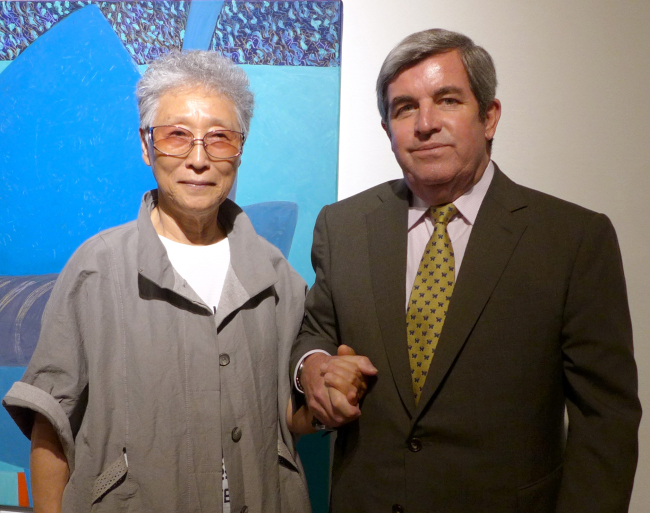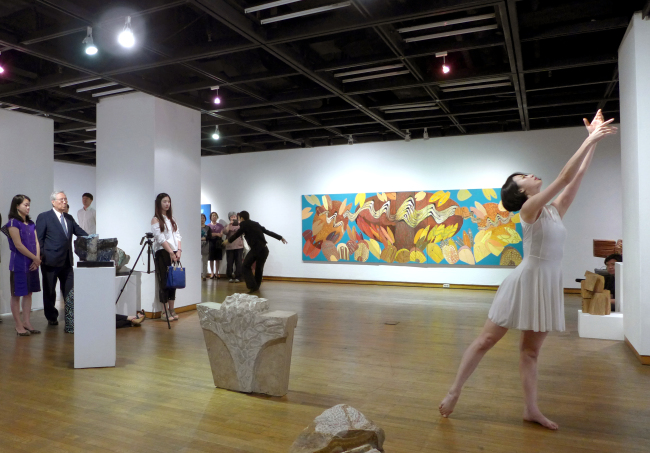An 80-year-old Korean-Argentine woman artist opened an exhibition in Seoul, bringing the two countries’ peoples closer through her spiritualism-oriented works.
Seventy art pieces of painting, wood sculpture and stonework by artist Kim Yun-shin are displayed at the Hanwon Museum of Art in Seoul from June 11-July 8.
Kim, a former professor at the Sangmyung University in Seoul, immigrated to Argentina in 1984, after a trip enchanted her.
Intense sun, pristine forests, vast meadows, idle cattle and free-spirited Argentines beckoned her, along with abundant stones and woods, which were rare materials for a Korean artist.
Kim devoted her next 30 years to the singular pursuit of art, and in 2008, opened her own museum ― Museo Kim Yun Shin ― in Buenos Aires. Former Vice President of Argentina Julio Cobos, Mayor of Buenos Aires Mauricio Macri and former Korean Ambassador to Argentina Hwang Eui-seung visited the museum.
Seventy art pieces of painting, wood sculpture and stonework by artist Kim Yun-shin are displayed at the Hanwon Museum of Art in Seoul from June 11-July 8.
Kim, a former professor at the Sangmyung University in Seoul, immigrated to Argentina in 1984, after a trip enchanted her.
Intense sun, pristine forests, vast meadows, idle cattle and free-spirited Argentines beckoned her, along with abundant stones and woods, which were rare materials for a Korean artist.
Kim devoted her next 30 years to the singular pursuit of art, and in 2008, opened her own museum ― Museo Kim Yun Shin ― in Buenos Aires. Former Vice President of Argentina Julio Cobos, Mayor of Buenos Aires Mauricio Macri and former Korean Ambassador to Argentina Hwang Eui-seung visited the museum.

At the opening of the exhibition on Thursday, which was attended by over two hundred guests, performance artists from KimBokHee Dance Company staged a live show with music. The venue is Kim’s 33rd exhibition, her 10th in Korea since 1988.
“Madam Kim Yun-shin, who is Korean by birth but Argentine by residence, will introduce interesting ways to bond our cultures,” Argentine Ambassador Jorge Roballo said in a speech.
“This year marks the 50th anniversary of Korean immigration to Argentina, and Koreans have demonstrated assiduous work ethics and harmonious assimilation with not only Argentines, but other immigrant communities.”
Kim said that she felt enthralled and elated to meet her former students again, who are now well into their 50s and 60s. Following the biblical story of ancient people, Kim plans to live and work until 125, she told The Korea Herald.
“I can move vigorously even at this age, because I have got used to the rigorous work regime every day,” Kim noted. “I have to move heavy stones, saw and sandpaper logs all day. This balances my life. If I didn’t do anything, I will forget about everything.”
Kim’s paintings have bright colors and leaf patterns. Her wood sculptures possess simple and crude forms, resembling aboriginal symbols. Her stonework cuts through the rock’s layers to expose compacted sedimentary patterns.

Unlike her former days, when she used to preconceive a design before cutting, these days, she relies on her “spiritual inspiration from the bottom of her heart,” the artist explained.
“My paintings are colorful and powerful, because I draw the inner forces underneath a Latin American society,” Kim highlighted. “I am not just drawing the European landscape of Argentina. I have tried to bring to light the aboriginal culture and spirit, which existed before the European immigration.”
Having lived in Argentina for 30 years, Kim said that she discovered the essence of Korean culture and identity on a foreign land.
As Koreans have historically lived in tight-knit communities, they have become zealous together, and no other people are as indefatigable as Koreans, Kim stressed.
“Koreans in Korea have taken our culture for granted,” she said. “We should not lose sight of our culture, which is important and precious. We should learn to embrace our imperfect circumstances gracefully.”
Argentines, by contrast, blessed with vast lands, food and resources, have developed a more leisurely lifestyle and attitude, according to Kim. In the mid-1980s, a family of 6 people could live comfortably off a hundred dollars, she recalled.
Some 30,000 Koreans in Argentina now have established themselves socially and economically, with the second generations branching off from the small businesses of their parents, to succeed in their white-collar professions.
Koreans came to Argentina largely before the Asian financial crisis of 1997, and the number dropped by half until 2003. Many first generations engaged in textile and clothing businesses.
“Koreans don’t come to Argentina as immigrants anymore,” Kim pointed out, adding that Argentina became a stopover country for transnational immigration.
“Most immigrants come to Argentina with capital, to make more money, and move onto America, Canada or Australia. I stay in touch with Koreans weekly through the Catholic church.”
By Joel Lee (joel@heraldcorp.com)
-
Articles by Korea Herald











![[Bridge to Africa] S. Korea-to-Zimbabwe value chains can foster ‘win-win’ cooperation](http://res.heraldm.com/phpwas/restmb_idxmake.php?idx=644&simg=/content/image/2024/05/14/20240514050881_0.jpg&u=20240515223025)







